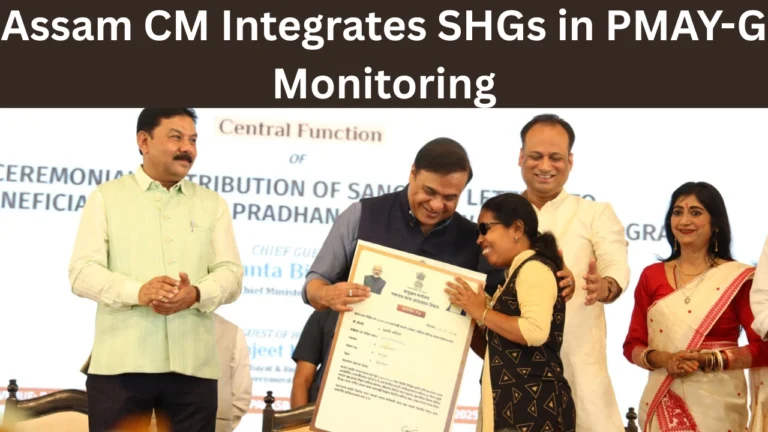Guwahati – In a significant move aimed at empowering women and enhancing transparency in housing allotments under the Pradhan Mantri Awas Yojana-Gramin (PMAY-G), the Assam government has decided to involve Self-Help Groups (SHGs) in the critical task of geo-tagging rural households. This step is expected to transform how beneficiary data is collected and verified, ensuring that only eligible individuals receive the benefits of the central government’s rural housing scheme.

Chief Minister Himanta Biswa Sarma announced the initiative on Thursday, stating that Assam will become the first state in India to involve women from SHGs, known as Jeevika Sakhis, in the geo-tagging of kutcha houses. These efforts will ensure the accurate identification of beneficiaries and reduce the scope of errors or misrepresentation.
Assam is amongst the few states which has moved up rapidly in the SDG India Index 2023 and achieved considerable milestones in development parameters. pic.twitter.com/3IQb34vBCf
— Himanta Biswa Sarma (@himantabiswa) July 17, 2024
A New Approach to Geo-Tagging
Geo-tagging is a vital step in the PMAY-G implementation process. It involves mapping the geographic coordinates of homes that require pucca houses under the scheme. Traditionally, this task was undertaken by government officials, but the Assam government is now shifting gears to involve local communities directly in the process.
“The geo-tagging will not be conducted by the Panchayat and Rural Development Department at the initial stage,” the Chief Minister clarified. “Instead, women from SHGs in nearby villages will be entrusted with this responsibility, making the process more community-driven and efficient.”
This innovative model is expected to boost both transparency and accountability. By engaging Jeevika Sakhis—trained and empowered women from the Assam State Rural Livelihood Mission (ASRLM)—the government also aims to strengthen women’s roles in grassroots governance.
Community Participation and Tech Integration
Apart from the SHG-led geo-tagging, the Assam government is also introducing a self-declaration method. Residents can now self-geo-tag their homes by submitting a photograph along with their address for initial verification. These submissions will later be validated by officials from the Panchayat and Rural Development Department.
All data collected—either through Jeevika Sakhis or self-reporting—will be uploaded on the Anwesha portal, a centralized platform to manage and monitor PMAY-G beneficiary data. This digital approach will help streamline records and prevent duplication or exclusion errors.
The Chief Minister emphasized that this survey will especially help identify those households that were left out in previous surveys. From March 17 onwards, Jeevika Sakhis will begin household visits to collect data using a standardized questionnaire and capture photographs of potential beneficiaries.
Defining Beneficiary Criteria
Eligibility under PMAY-G includes:
- Individuals or families who are homeless.
- Households residing in zero, one, or two-room homes made with kutcha walls and kutcha or CGI (corrugated galvanized iron) sheet roofs.
Conversely, families with houses featuring more than two rooms (excluding the kitchen), or those already in possession of pucca houses, will not qualify under the revised guidelines.
The initiative will be inclusive even within tea garden areas, where all eligible individuals will receive houses under PMAY-G regardless of their formal association with tea estate management. This includes those who already reside in company-allotted quarters, ensuring no deserving household is excluded.
A Transparent Verification System
The process for finalizing the list of beneficiaries includes multiple checks and community involvement. A Gram Sabha will first be organized to inform villagers about the survey. After data collection, another Gram Sabha will be held to publicly present the list compiled by the Gaon Panchayat Secretary. This list will then be displayed at the Block Development Office and Gram Panchayat offices, allowing villagers to raise objections or submit claims.
After this phase, the data will go through further scrutiny at two levels:
- Legislative Assembly Constituency-Level Committee – to validate the claims.
- District-Level Committee – to provide final approval before uploading the details on the AWAS app.
This multi-tiered verification ensures that the list of beneficiaries is robust and tamper-proof.
Scope and Timeline of Implementation
Union Rural Development Minister Shivraj Singh Chouhan, during his recent visit to Assam, announced that 7.6 lakh people will benefit under PMAY-G in the current phase. The first installment for house construction is set to begin on March 19 from Palasbari in Kamrup district.
Additionally, the remaining 3.8 lakh beneficiaries will be covered starting from April, with the entire process expected to be completed by May. However, in areas under the Rabha Hasong Council, allotments will begin after the local council elections conclude.
In total, 30 lakh people in Assam are estimated to require housing support under PMAY-G. Of these, 22 lakh have already received houses or have homes under construction.
Empowering Women Through Participation
Beyond housing, the involvement of SHGs in the geo-tagging process is part of a broader women empowerment drive by the Assam government. Speaking at the press conference, the CM also highlighted the Chief Minister’s Mahila Udyamita Scheme—another flagship initiative aimed at strengthening the economic role of women.
Under this scheme:
- ₹10,000 will be given as the first installment to 23,000 women SHG members in Behali in April.
- The scheme scales up to ₹25,000 in the second year and ₹50,000 in the third year, totaling ₹85,000, combining government support and bank credit.
Each installment is linked to skill training and entrepreneurial readiness, ensuring that women use the funds to launch or expand income-generating activities.
“This is one of the biggest empowerment schemes for women in the state after Orunodoi,” said Sarma. “By directly linking financial aid to women in SHGs, we are enabling them to become economic agents in their communities.”
FAQ’s
What is the new initiative involving women SHG members in Assam?
Assam has become the first state in India to engage women from Self-Help Groups, known as ‘Jeevika Sakhis’, to geo-tag ‘kutcha’ houses. This initiative aims to ensure the accurate identification of beneficiaries for the PMAY-G housing scheme.
Who is ‘Jeevika Sakhis’?
‘Jeevika Sakhis’ are women associated with SHGs under the Assam State Rural Livelihood Mission (ASRLM). They are trained to conduct surveys and collect data to identify eligible beneficiaries for government schemes like PMAY-G.
What is the role of Jeevika Sakhis in the PMAY-G scheme?
They are responsible for visiting households to identify and verify potential beneficiaries, collecting necessary details, and geo-tagging the locations of ‘kutcha’ houses. The collected data is then uploaded to the Anwesha portal for further processing.
Why are Jeevika Sakhis from neighboring villages involved instead of local officials?
To maintain transparency and avoid any potential bias, Jeevika Sakhis from neighboring villages are engaged in the process. This approach ensures an unbiased verification of beneficiaries

